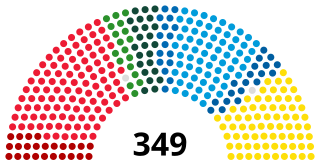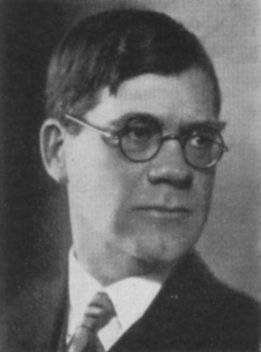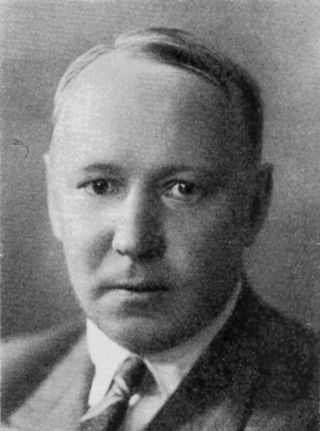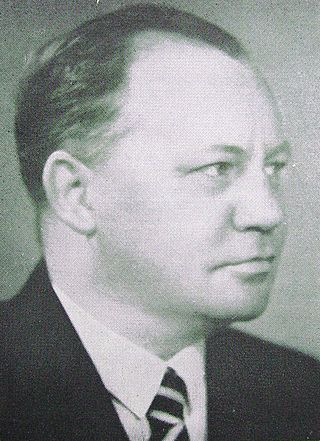
The Riksdag is the parliament and the supreme decision-making body of the Kingdom of Sweden. Since 1971, the Riksdag has been a unicameral parliament with 349 members, elected proportionally and serving, since 1994, fixed four-year terms. The 2022 Swedish general election is the most recent general election.

Per Albin Hansson was a Swedish politician, chairman of the Social Democrats from 1925 and two-time Prime Minister in four governments between 1932 and 1946, governing all that period save for a short-lived crisis in the summer of 1936, which he ended by forming a coalition government with his main adversary, Axel Pehrsson-Bramstorp. He has been described as one of the fathers of modern Sweden.

Tage Fritjof Erlander was a Swedish politician and statesman who served as the prime minister of Sweden and leader of the Social Democratic Party from 1946 to 1969. Previously, he served as minister of education from 1945 to 1946, and was a member of the Riksdag from 1932 to 1973. During his premiership, Sweden developed into one of the world's most advanced welfare states, with the "Swedish Model" at the peak of its acclaim and notoriety. His uninterrupted tenure of 23 years as head of the government is the longest ever in Sweden and in any modern Western democracy.

Bo Östen Undén was a Swedish academic (J.D.), civil servant and Social Democratic politician who served as acting Prime Minister of Sweden 6–11 October 1946, following the death of Per Albin Hansson (1885-1946).

Axel Alarik Pehrsson-Bramstorp was a Swedish politician and was Prime Minister of Sweden for a few months during 1936. As a parliamentarian he was known as Axel Pehrsson in Bramstorp, or just Bramstorp for short. In 1937 he officially added the name of his farm to his family name.
Folkhemmet is a political concept that played an important role in the history of the Swedish Social Democratic Party and the Swedish welfare state. It is also sometimes used to refer to the long period between 1932 and 1976 when the Social Democrats were in power and the concept was put into practice, but also works as a poetic name for the Swedish welfare state. Sometimes referred to as "the Swedish Middle Way", folkhemmet was viewed as midway between capitalism and socialism. The base of the folkhem vision is that the entire society ought to be like a family, where everybody contributes, but also where everybody looks after one another. The Swedish Social Democrats' successes in the postwar period is often explained by the fact that the party managed to motivate major social reforms with the idea of the folkhem and the national family's joint endeavor.

The Minister for Defence of Sweden is a member of the Government of Sweden. The Minister heads the Ministry for Defence and is appointed and dismissed at the sole discretion of the prime minister of Sweden.

The third cabinet of Per Albin Hansson was the cabinet of Sweden between 13 December 1939 and 31 July 1945. It consisted of members from the Social Democratic Party, the Farmers' League, the People's Party and the National Organization of the Right. It was a national unity government formed for reasons of national stability during World War II, and its constituent parties represented 219 out of the 230 seats in the Parliament of Sweden since the 1936 general election. Two parties of the 1936–1940 parliament were kept out of the government, the pro-Soviet Communist Party and the Socialist Party, which veered between Communist and Nazi positions, and lost its parliamentary representation in 1940. After the 1940 general election, the government represented 227 out of the 230 seats in parliament, and after 1944 general election, 215 out of 230.
The Midsummer crisis was a political crisis in Sweden after the beginning of Operation Barbarossa on 22 June 1941. Sweden's neutrality was tested when Nazi Germany and Finland demanded that Sweden allow the transit of the Wehrmacht's 163rd Infantry Division by railroad from Norway to Finland. After the 1939 German-Soviet invasion of Poland, Swedish prime minister Per Albin Hansson declared strict neutrality and called for the formation of a coalition government involving all major parties under his leadership; this was realized in December, with the exception of the Communist Party. With Spain, Portugal, Switzerland, Liechtenstein, Ireland and the Vatican, Sweden maintained neutrality throughout World War II and cooperated with both sides. According to Winston Churchill, during the war Sweden ignored the greater moral issues and played both sides for profit.
Events from the year 1946 in Sweden

The second cabinet of Per Albin Hansson was the cabinet of Sweden from 1936 to 1939. It was a coalition cabinet consisting of the two parties: Social Democrats and the Farmers' League.
Events from the year 1932 in Sweden.
Events from the year 1941 in Sweden

Axel Rubbestad was a Swedish farmer and politician. He represented the Farmers' League in the lower house of the Swedish bicameral parliament between 1933 and 1959, and he was a minister without portfolio in the coalition government headed by Per Albin Hansson which governed the country during World War 2. Rubbestad was Minister of Civil Affairs in 1943–44, and then Minister of Fuel from October 1944 until the government was dissolved in July 1945.
The first cabinet of Tage Erlander was the cabinet and government of Sweden between 11 October 1946 and 1 October 1951. It was formed following the sudden death of Prime Minister Per Albin Hansson on 6 October 1946.

Thorwald Bergquist was a Swedish politician who held various cabinet and political posts. He was a member of the People's Party. Johan Östling argues that Bergquist was one of the Swedish generation of 1945 figures who had a rationalist approach towards cultural affairs and who experienced the World War I period.

Henning Leo (1885–1953) was a Swedish social democrat politician and the secretary of the Union of Railroad Engineers. He served as the minister of communications (Transport) from 1932 to 1936.

Axel Gjöres (1889–1979) was a Swedish social democrat politician who served in different government posts. He was the minister of supply between 1941 and 1947 and minister of commerce and industry between 1947 and 1948.

Janne Nilsson (1882–1938) was a Swedish politician who was a member of the Parliament and the minister of defense between 1936 and 1938.

Gerhard Strindlund (1890–1957) was a Swedish politician who held various cabinet posts in the 1930s. He was a member of the Agrarian Party.














